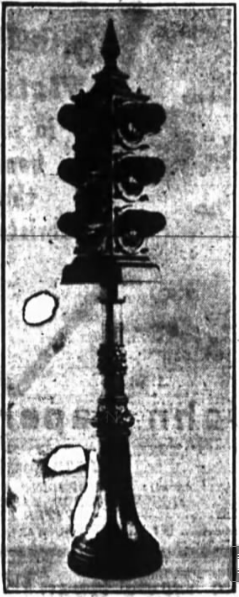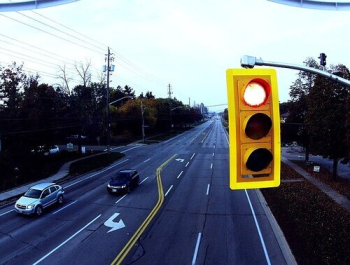5 March 1928
It’s hard to imagine city driving without the ubiquitous traffic lights that govern the ebb and flow of cars, trucks, cyclists and pedestrians on our streets and avenues. For the most part, we take them for granted. But when a power failure temporarily puts out the lights, the resulting gridlock reminds us how much we rely on them to keep our roads safe and traffic flowing. In contrast, back in the days before the arrival of the automobile when life moved at a more leisurely pace, there was little in the way of traffic controls. Even whether one should keep to the left or to the right was uncertain. As well, everybody had the same right to use the streets and highways as long as one took care not to injure others. Intermingled among horse-drawn delivery wagons, hansom cabs and omnibuses were cyclists and pedestrians. Not only was jaywalking an unheard-of offence, people thought nothing of strolling down the centre of the street.
The pace of life began to quicken in the late nineteenth century with the introduction of electric streetcars. But the arrival of the automobile in large numbers early in the twentieth century was the real game changer. With the rules of the road ill-defined, city streets had become increasingly dangerous. Traffic control became a priority in all major cities. To gain an appreciation of the chaotic traffic conditions in a major North American city during the early 1900s, here is a link (San Francisco Street Scene) to a fascinating short film of a drive down Market Street in San Francisco just days before the famous earthquake devastated the city in 1906.
Traffic lights actually predate the automobile. In late 1868, gas-lit signals were installed at the intersection of Bridge, Great George and Parliament Streets close to the Houses of Parliament in London to help control heavy horse-drawn and pedestrian traffic. Adapted from railway signals by engineer John Peake Knight, the three semaphore signal arms stood on a pillar twenty-two feet high. The horizontal signal arms indicated “stop” and “proceed with caution.” At night, gas lights were used with coloured lenses. Similar to today, a red light indicated that traffic should stop and a green light “proceed with caution.” The lights and signals were manually controlled by a police constable who would also blow a whistle to indicate he was about to change them. Although the new invention was effective at controlling traffic, a month after its installation a gas leak led to an explosion that severely injured the attending constable. This effectively scuppered gas-powered traffic signals in London.
Fast forward to the early years of the twentieth century, manually-powered semaphore traffic signals were used in many American cities to help control traffic. Like their British counterpart, the arms indicated whether traffic should stop or go. Instead of gas, kerosene was sometimes used to light lamps at night, with the standard red or green lenses indicating “stop” and “go,” respectively. In 1923, the inventor Garrett Morgan of Cleveland successfully took out a U.S. patent (# 1,475,024) for a hand-cranked semaphore traffic signal that featured three positions: stop, go, and all stop so that traffic could give way to pedestrians. Morgan reportedly sold his invention for $40,000 to the General Electric Company, a considerable sum in those days.
Traffic lights as we know them date from 1912 when one Lester Wire of Salt Lake City, Utah, who was head of the city’s traffic squad, invented a two-colour, red-green system. Wire never patented his device though it was apparently employed in Salt Lake City. In 1913, James Hoge of Cleveland submitted a patent in the United States for an electric “Municipal Traffic Control System” that consisted of “traffic control boxes or signals at street intersections and other suitable points.” Hoge’s objective was to permit policemen to better control traffic in order to give priority to emergency vehicles. Lamps of different colours would be used with one colour (red) to indicate “stop” and another colour (white) to indicate “move.” He received his patent (# 1,251,666) on 1 January 1918.
The modern, three-colour (red, amber, and green), electric traffic light, first appeared on street corners in Detroit in 1920. Its inventor was William L. Potts, a police officer who, like others at that time, was concerned about worsening road safety owing to the increasing popularity of the automobile. Like Lester Wire before him, Potts did not patent his device, apparently because being a government employee he was not eligible to do so. Within a few years, Potts’s three-colour, electric traffic lights were being widely used in American cities.
Electric traffic lights came to Canadian streets in 1925, first in Hamilton, Ontario and shortly afterwards in Toronto as a means of reducing the number of police constables directing traffic at major intersections. Taking note of Toronto’s favourable experience with traffic lights, police magistrate Charles Hopewell wrote in late 1927 to Ottawa’s Mayor John Balharrie and City Council recommending traffic lights of the three-colour variety be installed as an experiment at three major intersections on Sparks Street—at Bank, Metcalfe, and O’Connor Streets. He recommended against installing lights at the intersection of Sparks and Elgin Streets owing to uncertainty over government plans for the area. The Dominion government had recently expropriated land in this area, including the site of the old Russell Hotel, with a view towards beautifying Ottawa, which included widening Sparks and Elgin Streets. At each of the three chosen intersections, four traffic lights would be installed on the existing “Whiteway” lamp poles. Hopewell recommended the “Co-ordinated Progressive System” of traffic lights made by the Canadian General Electric Company over equipment manufactured by the Northern Electric Company, a forerunner of Northern Telecom. He estimated the purchase and installation costs at approximately $2,600 (about $37,000 in today’s money). After consulting the Ottawa Hydro-Electric Commission, the annual electricity cost for running the twelve sets of traffic lights, each equipped with three 60 watt bulbs, was estimated at $640.
Although Council supported Hopewell recommendation to install traffic lights on Sparks Street, the Police Commission in December gave the contract to Northern Electric rather than Canadian General Electric. The cost of buying its automatic traffic control system with twelve sets of lights was under $1,800, much lower than Hopewell’s initial estimate. The funds to buy the equipment came out of unused resources in the police department’s 1927 budget. Of the twelve sets of traffic lights, eleven were mounted horizontally on existing light poles. The twelfth was mounted vertically to see which configuration of lights would be more visible.
Although newspapers optimistically reported that the traffic lights would be ready for Christmas, it took longer than expected for the hydro company to connect them. Finally, shortly before 8am on Monday, 5 March 1928, the new, automatic traffic lights on Sparks Street were switched on. The street lights were synchronized to facilitate travel down the street. They were on a 45-second cycle, with a twenty-second green light, followed by a five-second amber caution light, and a twenty-second red light. Twenty seconds were deemed sufficient time to allow streetcars to unload and load their passengers. Initially, the lights were in operation Monday through Saturday. Extra police were on hand that first day to assist the public in observing the rules. Magistrate Hopewell was also there to witness the lights in use for the first time. He returned at noon to check how things were running.
Overall, the introduction of traffic lights went smoothly, though the volume of traffic was unusually light that first day, possibly owing to cold weather. The street cars were running normally, however, allowing police officials to check the timing of the lights. Groups of people stood around the street corners to watch the lights change colour. A number of car drivers and streetcar operators drove through red lights, but police overlooked the infractions owing to people’s unfamiliarity with the new system. Police also stressed that pedestrians should obey the lights as well.
 The pedestal street lights installed on Wellington Street in 1928, The Ottawa Evening Journal, 28 November 1928.Naturally, there were complaints. Some motorists didn’t like the location of the lights. Magistrate Hopewell said it would take at least a week for the traffic lights to prove their efficiency. In the meantime, the system would be studied and improved, if necessary.
The pedestal street lights installed on Wellington Street in 1928, The Ottawa Evening Journal, 28 November 1928.Naturally, there were complaints. Some motorists didn’t like the location of the lights. Magistrate Hopewell said it would take at least a week for the traffic lights to prove their efficiency. In the meantime, the system would be studied and improved, if necessary.
The new lights were judged to be a complete success, and were quickly rolled out to other important road junctures, including the Sparks and Kent and the Bank and Laurier intersections a few months later. The operation of the street lights was also extended to Sundays.
Wellington Street received its traffic lights in late 1928 at intersections with Elgin, Metcalfe, O’Connor, and Bank Streets. Instead of installing the lights on existing poles, new pedestal-type traffic lights were erected—a first in Canada. The lights, with top red, middle amber, and bottom light green, were mounted on pedestals with a two-foot base, standing over nine-feet high. The city had hoped to have the new traffic lights in operation earlier in the year, but delayed their installation pending approval from Prime Minister Mackenzie King who took a personal interest in plans to improve the Capital. The traffic lights were synchronized so that automobiles travelling at twenty miles per hour from the Château Laurier Hotel to Bank Street would not have to stop. The Ottawa Evening Journal proudly noted that Ottawa was the only city in North America, other than Buffalo, New York, to have an entire thoroughfare equipped with these new type of lights.
From then on, there was no looking back. Traffic lights, proven effective at controlling the flow of traffic and improving road safety, were here to stay.
Sources:
About Money, 2016. “Garrett Morgan 1877-1963,” http://www.todayifoundout.com/index.php/2012/03/the-origin-of-the-green-yellow-and-red-color-scheme-for-traffic-lights/.
Bio, 2016. “Garrett Morgan Biography,” http://www.biography.com/people/garrett-morgan-9414691#cleveland-tunnel-explosion.
Brown, J. E., General Manager, Ottawa Hydro-Electric Commission to Mr. C.E. Pearce, Board of Control, 1927. “Letter,” 24 October.
City of Ottawa, 1927. “Minutes,” Traffic Control System, 6 December.
Globe and Mail, 2015. “First electric traffic signal installed 101 years ago,” 5 August.
History, 2016. “First electric traffic signal installed,” This Day in History, August 5. http://www.history.com/this-day-in-history/first-electric-traffic-signal-installed.
Hopewell, Charles, Police Magistrate, to Mayor and Board of Control, 1927. “Letter.” 3 October.
——————————————————-, 1927. “Letter.” 5 December.
Idea Finder, 2007, “Traffic Lights,” http://www.ideafinder.com/history/inventions/trafficlight.htm.
Mark Traffic, 2016. “Traffic Lights Invented by William L. Potts,” http://www.marktraffic.com/traffic-lights-invented-by-william-l-potts.php.
Ottawa Evening Journal (The), 1927. “Traffic Lights Installed For Holiday Rush,” 12 December.
————————————, 1928. “New Automatic Signal System In Operation.” 5 March.
————————————, 1928. “Wellington St. Traffic Lights Now Are Likely,” 27 April.
————————————, 1928. “Traffic Lights To Operate Sundays,” 7 May.
————————————, 1928. “Ottawa To Get Latest Types Signal Lights,” 28 November.
Today I Found Out, 2016. “The Origin of the Green, Yellow and Red Color Scheme For Traffic Lights,” http://www.todayifoundout.com/index.php/2012/03/the-origin-of-the-green-yellow-and-red-color-scheme-for-traffic-lights/.
U.S. Patent Office, 1918. “Municipal Traffic Control Signal of J. B. Hoge, Patent Number 1251666,” 1 January, https://www.google.com/patents/US1251666.
Story written by James Powell, the author of the blog Today in Ottawa's History.
Retired from the Bank of Canada, James is the author or co-author of three books dealing with some aspect of Canadian history. These comprise: A History of the Canadian Dollar, 2005, Bank of Canada, The Bank of Canada of James Elliott Coyne: Challenges, Confrontation and Change,” 2009, Queen’s University Press, and with Jill Moxley, Faking It! A History of Counterfeiting in Canada, 2013, General Store Publishing House, Renfrew, Ontario. James is a Director of The Historical Society of Ottawa.






